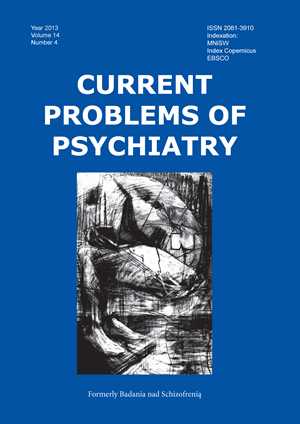Relations in the families of women at risk and not at risk of mobile phone addiction
Keywords:
mobile phone addiction, family relationsAbstract
The aim of this work was to verify the hypothesis that there are statistically significant differences between women at risk and not at risk of mobile phone addiction in their relationships with their parents.
Material and methods. The study included 80 women at a mean age of 25 years. The following instruments were used in this study: a socio-demographic questionnaire, the Mobile Phone Addiction Assessment Questionnaire by Potembska and Pawłowska, and Pawłowska's Parent-Child Relationship Questionnaire. Based on the general KBUTK scale a group of 30 women at risk of mobile phone addiction was singled out as well as a group of 50 women who were not at risk of this addiction.
Results. The women at risk of mobile phone addiction significantly more often, as compared to women who are not at risk of this addiction, inform us about emotional violence experienced from their parents, punishment, sense of loneliness in the family, lack of acceptance, understanding, lack of interest in their problems and not taking into account their opinion. They experience a lack of support and care, they think that parents need their support because they are helpless, they mention participation in the conflicts between their parents, feel guilty for their problems and think that their existence is the cause of the problems of their parents as well as of their failures and conflicts between them. The women at risk of mobile phone addiction significantly more often as compared to the control group (i.e. women who are not at risk of this addiction) inform us that they drew their parents’ attention only when they were sick or caused problems at school and indicate that their parents formulated contradictory requirements in relation to them, they undermined up-bringing principles practised by the other parent, they indicate that they were a disappointment to their mothers and that in the future they would not like to be like their mothers as well as that they are afraid of adult life.
The results of linear regression show that addiction to mobile phone conversation as well as texting, their symptoms being: making unsuccessful attempts to cut down on the number of conversations and text messages, limiting the hours of sleep due to phone conversations, paying extremely high bills exceeding their budget for phone conversations and text messages, concealing the costs of phone conversations from their families, belittling the number of mobile phone conversations, are accounted for in 73% by family factors: sense of lack of understanding shown by their parents, being a disappointment to their mothers, experience of indifference and lack of time shown by their parents and of situations when the examined women defended their mothers from their fathers. The experience of loneliness in a situation when no phone conversations and text messages are received is accounted for in 57% by the following: fear of adult life and parents’ indifference to their children’s problems. Excessive use of mobile phone in order to listen to music, make films, take pictures, play games, stay online account for 37% of family factors: participation in conflicts between parents and assuming responsibility for the fathers’ conduct. Preferring interpersonal interactions and expressing emotions via phone conversations and text messaging to “face- to -face” interactions as shown by the examined women account for 46% of the desire to get care and advice and by the sense of indifference shown by their mothers when they mentioned problems.
Conclusions.
- Women at risk of mobile phone addiction assessed their relationships with their parents significantly more negatively than women at no risk of this addiction.
- Women at risk of mobile phone addiction more frequently than women not at risk had experienced conflicts, loneliness, emotional abuse, punishment, and lack of acceptance, understanding and interest in their families.
- The most significant predictors of mobile phone addiction include family factors, in particular, experiencing indifference, lack of understanding, disappointment with the child from their parents, sense of loneliness in a family as well as the fear of adult life.
References
1. Golińska L. Osobowościowe mechanizmy pracoholizmu. W: Golińska L., Dudek B. red., Rodzina i praca z perspektywy wyzwań i zagrożeń. Łódź; UŁ: 2008, s.21-29.
2. Potembska E. Uzależnienie i zagrożenie uzależnieniem od Internetu u młodzieży. Niepublikowana rozprawa doktorska, Uniwersytet Medyczny w Lublinie, Lublin 2011.
3. Tsitsika A, Critselis E, Louizou A, Janikian M, Freskou A, Marangou E, Kormas G, Kafetzis D. Determinants of Internet Addiction among Adolescents: A Case-Control Study. Scientific World Journal 2011; 11: 866-874.
4. Pawłowska B., Dziurzyńska E. Relacje w rodzinie a uzależnienie od gier komputerowych u młodzieży. Curr. Probl. Psychiatry, 2012; 13(3): 196-208.
5. Chuchra M., Wróblewska M. Aktywność w sieci i relacje rodzinne młodzieży licealnej. Curr. Probl. Psychiatry, 2013; 14(3): 141-151.
6. Potembska E, Pawłowska B. Właściwości psychometryczne Kwestionariusza do Badania Uzależnienia od Telefonu Komórkowego (KBUTK). Bad. Schizofr. 2009; 10: 322-329.
7. Pawłowska B, Potembska E. Objawy zagrożenia i uzależnienia od telefonu komórkowego mierzonego Kwestionariuszem do Badania Uzależnienia od Telefonu Komórkowego, autorstwa Potembskiej i Pawłowskiej u młodzieży w wieku do 13 do 24 lat. Curr. Probl. Psychiatry 2011; 12(4): 395-397.
8. Ogińska-Bulik N. Uzależnienie od czynności. Mit czy rzeczywistość? Warszawa; Difin: 2010.
9. Tafa M., Baiocco R. Addictive Behavior and Family Functioning During Adolescence. Am. J. Fam. Ther., 2009; 37: 388-395.
10. Wang P.W., Liu T.L., Ko C.H., Lin H.C., Huang M.F., Yeh Y.C., Yen C.F. Association between Problematic Cellular Phone Use and Suicide: The Moderating Effect of Family Function and De-pression. Compr. Psychiatry, 2013; pii: S0010-440X(13) 00282-4. doi: 10.1016/j.comppsych. 2013.09.006.
11. Trawiński A. Rodzina w sieci internetowej. Szanse, wyzwania, zagrożenia. Roczniki Nauk o Rodzinie, 2011; 3(10): 229-244.
12. Levinson P. Telefon komórkowy. Jak zmienił świat najbardziej mobilny ze środków komunikacji. Warszawa; Warszawskie Wyd. Lit. MUZA SA: 2006.


